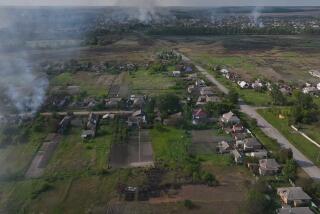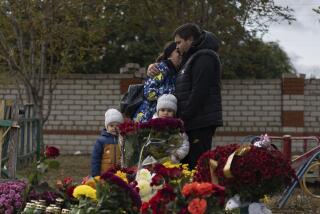U.N. Urges Cleanup of ‘Hot Spots’ Left by Kosovo War
- Share via
PRISTINA, Yugoslavia — Urgent steps are needed to clean up “hot spots” of pollution created by NATO bombing of Yugoslavia during the spring, but the conflict did not cause as much environmental damage as some observers feared, a United Nations team reported Tuesday.
The Balkans Task Force study of major bombing targets identifies four pollution sites where it urges “immediate action from a humanitarian point of view.”
Most of the pollution at bombing sites, however, was caused by chronic sources rather than NATO bombing, Pasi Rinne, a task force official, said at a news conference here.
“Perhaps 70% of the pollution had existed there before,” he said.
The study, sponsored by the U.N. Environment Program and the U.N. Center for Human Settlements, found no evidence that the North Atlantic Treaty Organization’s 78-day bombing campaign released enough pollutants to increase the risk of birth defects among the fetuses of pregnant women, said Otto Simonett, another team member.
There were widespread fears of this during and after the airstrikes, with much talk that pregnant women living near hard-hit industrial sites should consider having abortions.
Examination of the Danube River showed that it suffers more severe chronic pollution than most experts had believed, with much of that toxicity coming from upstream sources, Rinne said. The Danube flows through or borders Germany, Austria, Slovakia and Hungary before entering Yugoslavia.
Water and sediment samples upstream from Novi Sad, an industrial city in northern Yugoslavia hit hard during the NATO air campaign, “were more polluted with mercury than downstream,” Rinne said.
Rinne added that Yugoslavia as a whole is “suffering from the fact that technology used in factories is outdated. They have not followed the technological advances developed during the past 10 or 15 years, nor have they followed the environmental management developments.
“For both of these reasons,” he said, “the chronic pollution from their factories is relatively high.”
Rinne stressed that the hot spots identified in the study “should be handled as places where humanitarian assistance is needed,” despite international economic sanctions imposed on Yugoslavia.
The sites of urgent concern identified in the 104-page study are in four cities:
* Pancevo. NATO bombed a major industrial complex that included a petrochemical plant, a fertilizer plant and an oil refinery. This caused “serious leakages of 1,2-dichloroethane (EDC) and mercury; burning of vinyl chloride monomer to form dioxins; burning of 80,000 tons of oil and oil products releasing sulfur dioxide and other noxious gases; high concentrations of EDC found in water of [a] canal running into the Danube; high concentrations of mercury and petroleum products in the canal sediments.”
* Kragujevac. Heavy damage was inflicted on the Zastava car factory complex, including a power station, assembly line, paint shop, computer center and truck plant, releasing high levels of potentially harmful dioxins and polychlorinated biphenyls, or PCBs.
* Novi Sad. This city’s oil refinery was a principal target of NATO bombing. Concerns now center on “the risk that ground water polluted with petrochemicals from oil refinery could enter drinking water wells.”
* Bor. Airstrikes targeted a copper mine and smelting plant and a nearby oil depot. Disruption of the copper mine operations has led to the chronic release of large quantities of sulfur dioxide gas. Damage to electric facilities caused localized PCB contamination.
“It is important to ensure the safety of the environment and the cleanup of these areas immediately, in order to avoid risks to human health and long-term ecological damage,” the report says.
The study found no significant war-related pollution in Kosovo, which is under U.N. administration but technically remains a province of Serbia, the dominant republic in Yugoslavia. It also found no evidence in Yugoslavia of radioactivity caused by NATO use of ammunition tipped with depleted uranium. It stresses, however, that “it is necessary to obtain information from NATO confirming if, when and where depleted uranium was used during the Kosovo conflict.”
Depleted uranium, a waste product of the process that enriches uranium for use in nuclear reactors and nuclear weapons, is a high-density metal that is about one-third as radioactive as natural uranium. It is used in bullets designed to pierce armor plating and in the nose cones of some cruise missiles.
A U.S. Defense Department news briefing on May 3 “appeared to confirm that depleted uranium weapons had been used by U.S. forces in the Balkans,” the study says.
The task force was unable, however, to get confirmation of depleted uranium use or maps of possibly contaminated areas from NATO, its member states or the Yugoslav government, the study adds.
More to Read
Sign up for Essential California
The most important California stories and recommendations in your inbox every morning.
You may occasionally receive promotional content from the Los Angeles Times.













